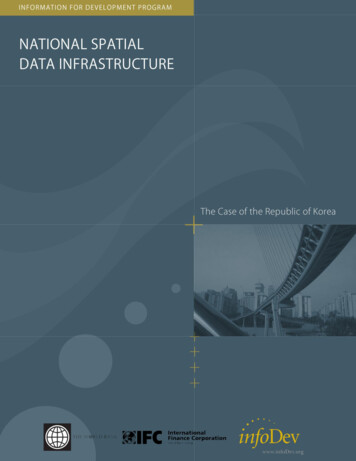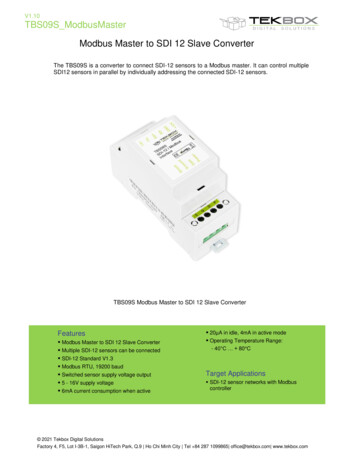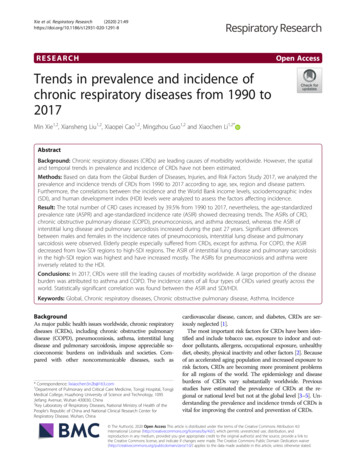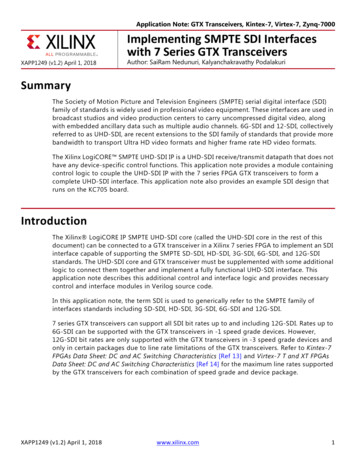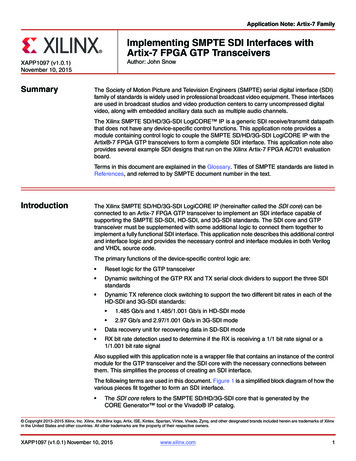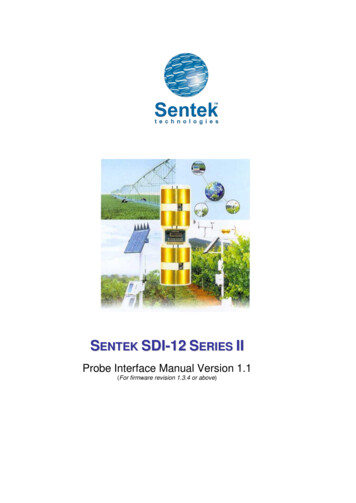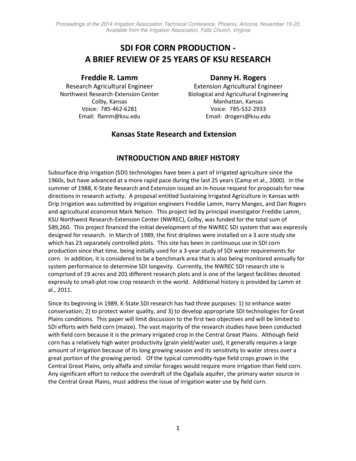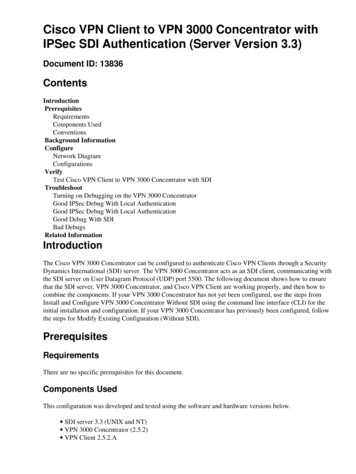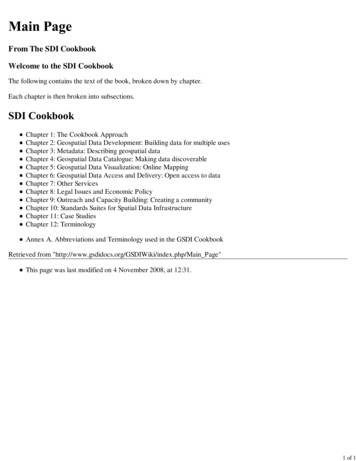
Transcription
From The SDI CookbookWelcome to the SDI CookbookThe following contains the text of the book, broken down by chapter.Each chapter is then broken into subsections.Chapter 1: The Cookbook ApproachChapter 2: Geospatial Data Development: Building data for multiple usesChapter 3: Metadata: Describing geospatial dataChapter 4: Geospatial Data Catalogue: Making data discoverableChapter 5: Geospatial Data Visualization: Online MappingChapter 6: Geospatial Data Access and Delivery: Open access to dataChapter 7: Other ServicesChapter 8: Legal Issues and Economic PolicyChapter 9: Outreach and Capacity Building: Creating a communityChapter 10: Standards Suites for Spatial Data InfrastructureChapter 11: Case StudiesChapter 12: TerminologyAnnex A. Abbreviations and Terminology used in the GSDI CookbookRetrieved from "http://www.gsdidocs.org/GSDIWiki/index.php/Main Page"This page was last modified on 4 November 2008, at 12:31.1 of 1
From The SDI Cookbook1 Chapter One: The Cookbook Approach1.1 Introduction1.2 Scope of This Cookbook1.3 Spatial Data Infrastructures1.4 The Global Spatial Data Infrastructure1.5 Distribution1.6 Contributors1.7 Organisation1.8 Cookbook Overview1.8.1 Chapter 2: Geospatial Data Development: Building data for multiple uses1.8.2 Chapter 3: Metadata: Describing geospatial data1.8.3 Chapter 4: Geospatial Data Catalogue: Making data discoverable1.8.4 Chapter 5: Geospatial Data Visualization: Online Mapping1.8.5 Chapter 6: Geospatial Access and Delivery: Open access to data1.8.6 Chapter 7: Other Services1.8.7 Chapter 8: Legal Issues and Economic Policy1.8.8 Chapter 9: Outreach and Capacity Building: Creating a community1.8.9 Chapter 10: Case Studies1.8.10 Chapter 11: TerminologyIntroductionAt the United Nations Conference on Environment and Development in Rio de Janeiro in 1992, a major resolution waspassed to focus on reversing the impacts caused by environmental deterioration. The Agenda 21 resolution establishesmeasures to address deforestation, pollution, depletion of fish stocks, and management of toxic wastes to name a few.The importance of geographic information to support decision-making and management of these growing national,regional, and global issues was cited as critical at the 1992 Rio Summit, and by a special session of the United NationsGeneral Assembly assembled in 1997 to appraise the implementation of the Agenda 21. In 2003, a landmark effort wasmade to illustrate the capabilities, benefits, and possibilities of using online digital geographic information for sustainabledevelopment at the World Summit on Sustainable Development in Johannesburg, South Africa.Geographic information is vital to making sound decisions at the local, regional, and global levels.Crime management,business development, flood mitigation, environmental restoration, community land use assessments and disasterrecovery are just a few examples of areas in which decision-makers are benefiting from geographic information, togetherwith the associated infrastructures (i.e. Spatial Data Infrastructure or SDI) that support information discovery, access,and use of this information in the decision-making process. However, information is an expensive resource, and for thisreason appropriate information and the resources to fully utilize this information may not always be readily available,particularly in the developing world. Many national, regional, and international programs and projects are working toimprove access to available spatial data, promote its reuse, and ensure that additional investment in spatial information1 of 6
collection and management results in an evergrowing, readily available and useable pool of spatial information. This istrue of many initiatives even if they are not actually labelled as “SDI initiatives”. An example of this is the EnvironmentInformation System Program in sub-Saharan Africa (EIS-SSA). An emphasis on harmonising standards for spatial datacapture and exchange, the co-ordination of data collection and maintenance activities and the use of common data setsby different agencies may also feature in such initiatives, although these activities by themselves do not constitute aformal SDI.In regions characterised by an availability of geographic information, in combination with the power of GeographicInformation Systems (GIS), decision support tools, data bases, and the World Wide Web and their associatedinteroperability, the way better-resourced communities address critical issues of social, environmental, and economicimportance is changing rapidly. However, even in the new era of networked computers, the social habits of the pastcontinue to prohibit users from finding and using critical geographic information. This can lead to either the abandoningof a proposed project, or to unnecessary – and expensive - recapture of existing geographic information. In manyagencies there is still the lost opportunity to reuse incidental digital geographic information collected for other purposes.There is a clear need, at all scales, to be able to access, integrate and use spatial data from disparate sources in guidingdecision making. Our ability then, to make sound decisions collectively at the local, regional, and global levels, isdependent on the implementation of SDI that provides for compatibility across jurisdictions that promotes data accessand use.Only through common conventions and technical agreements will it be easily possible for local communities, nations andregional decision-makers to discover, acquire, exploit and share geographic information vital to the decision process. Theuse of common conventions and technical agreements also makes sound economic sense by limiting the cost involved inthe integration of information from various sources, as well as eliminating the need for parallel and costly development oftools for discovering, exchanging and exploiting spatial data. The greater the limitation on available resources for SDIdevelopment, the greater the incentive for achieving alignment between initiatives to build SDI.The development of a "cookbook" is envisaged as a means to clarify the SDI definition and to share the currentexperiences in building SDI implementations that are compatible at many scales of endeavour. This cookbook is intendedto be a dynamic document available in printed and digital form, to include "recipes" or recommendations on developingthese infrastructures from a local, even non-governmental, scale through global initiatives.Scope of This CookbookThis SDI Implementation Guide or Cookbook, through the support of the Global Spatial Data Infrastructure community,provides geographic information providers and users with the necessary background information to evaluate andimplement existing components of SDI. It also facilitates participation within a growing (digital) geographic informationcommunity known as the Global Spatial Data Infrastructure (GSDI).To enable builders of SDI to make use of and build on existing SDI components in a way which makes their endeavorscompatible with the efforts of other SDI builders, this GSDI Cookbook identifies:existing and emerging standards,open-source and commercial standards-based software solutions,supportive organisational strategies and policies andbest practices.Working within a common framework of standards and tools based on these standards also makes it possible to maximisethe impact of the total available resources for SDI creation through future co-operation -- e.g. we develop this, youdevelop that, and then we share. Although proprietary or project-based solutions for information sharing continue toexist, the adoption of consistent geospatial data sharing principles will in general provide a better solution for informationdissemination, through publishing geospatial data using the Internet and computer media. In an increasingly “globalcommunity”, there is a need to ensure that transnational implementations and common knowledge bases are available.Ultimately, these SDI activities should improve collaboration within the geospatial data industry and make the benefits2 of 6
derived from the use of geographic information part of everyday life for all.Spatial Data InfrastructuresThe term “Spatial Data Infrastructure” (SDI) is often used to denote the relevant base collection of technologies, policiesand institutional arrangements that facilitate the availability of and access to spatial data. The SDI provides a basis forspatial data discovery, evaluation, and application for users and providers within all levels of government, thecommercial sector, the non-profit sector, academia and by citizens in general.The word infrastructure is used to promote the concept of a reliable, supporting environment, analogous to a road ortelecommunications network, that, in this case, facilitates the access to geographically-related information using aminimum set of standard practices, protocols, and specifications. The applications that run “on” such an infrastructureare not specified in detail in this document. But, like roads and wires, an SDI facilitates the conveyance of virtuallyunlimited packages of geographic information.An SDI must be more than a single data set or database; an SDI hosts geographic data and attributes, sufficientdocumentation (metadata), a means to discover, visualize, and evaluate the data (catalogues and Web mapping), andsome method to provide access to the geographic data. Beyond this are additional services or software to supportapplications of the data. To make an SDI functional, it must also include the organisational agreements needed tocoordinate and adminster it on a local, regional, national, and or trans-national scale. Although the core SDI conceptincludes within its scope neither base data collection activities or myriad applications built upon it, the infrastructureprovides the ideal environment to connect applications to data – influencing both data collection and applicationsconstruction through minimal appropriate standards and policies.The creation of specific organisations or programs for developing or overseeing the development of SDI, particularly bygovernment at various scales can be seen as the logical extension of the long practice of co-ordinating the building ofother infrastructures necessary for ongoing development, such as transportation or telecommunication networks.The Global Spatial Data InfrastructureJust as SDI programs of necessity involve the alignment of scarce resources for achieving success, so too it is necessaryto ensure that the SDI initiatives develop in harmony with each other in order to maximise the impact of theseprogrammes. In reality, many initiatives are working in isolation, not necessarily developing in harmony with others andconsequently unable to reap the benefits of working together.Anyone who is involved in a project of which spatial information forms an integral part and who intends leaving a legacyof spatial data or tools to exploit the data that lasts beyond the period of funding for the project is, by definition,participating in some of the fundamental elements required by an SDI. As coordination between such organisationsexpands, these projects very often lay the foundations on which initiatives formally dedicated to the establishment of SDIcan then build. See Chapter 9 for specific case studies.At a global scale, the most prominent examples of formal SDI programs are on a national scale. Most of these are drivenby the national or federal government (e.g. the NSDI in the USA, the SNIG in Portugal, Australia’s ASDI, Malaysia’sNaLIS, South Africa’s NSIF, Colombia, or the multi-national INSPIRE Initiative in Europe), but there are exceptionssuch as the Uruguay Clearinghouse and NGDF in the United Kingdom, which have largely been driven by the privatesector. In most cases the need for wide participation in the development of lasting, useful SDI is acknowledged, and soprivate-public partnerships are encouraged. The beneficiaries of SDI are generally seen to derive from the public andprivate sectors, academia and non-governmental organisations, as well as individuals. Federal countries are often able tobuild their national SDI programs on SDI programs being driven by provincial or state governments (e.g. the ASDI ofAustralia). Regional SDI initiatives often arise out of existing multilateral structures (e.g. the Permanent Committee forGIS Infrastructure in Asia and the Pacific was formed through the UN Regional Cartographic Conference for theAsia-Pacific region).3 of 6
DistributionThis GSDI Cookbook wiki is intended to be a "living" and dynamic document that can be updated as new principles andtechnologies are adopted. Distribution of this Cookbook is intended primarily via the World Wide Web, althoughelectronic copies will also be made available on other physical media such as PDF, CD-ROM and printed copy foraudiences that are not well connected to the Internet at this time.Should you be reading this via the World Wide Web and wish to obtain a soft or hard copy, please contact the GSDIsecretariat, at www.gsdi.org .ContributorsContributions to this GSDI Cookbook are indeed global and are intended to satisfy many different categories ofparticipants. This was a deliberate choice, in order to ensure that the Cookbook represented various perspectives fromaround the globe, to ensure both that the collective global experience and existing resources would be represented in theCookbook, and that its applicability could truly be global. The migration of the cookbook to a wiki environment is alogical extension of this idea, allowing contributions to be provided on an ongoing basis.The cookbook will be periodically revised by selected and nominated editors to create a concise version that can bepublished as a electronic and paper document. This will allow outreach to people with an interest in SDI developmentwho may not have ready access to the wiki version.OrganisationEach chapter is organised into three major sections that correspond to levels of detail and application:The first section in each chapter establishes the background, context, and rationale for the subject suitable asgeneral orientation for all readers, but targeted for managers and end-usersThe second section addresses the design architecture of organisations, roles, and software systems that areintended to interactThe third section addresses the implementation with review of existing standards, protocols, and software asappropriateEach chapter is approximately 10 to 20 pages in length with links to other relevant documents. Use-case scenarios andillustrations are featured in some chapters as inset boxes to further build understanding. Most chapters have a set ofrecommendations placed in a summary. Terminology used in this document, as well as guidance on how to standardizeterminology, is presented in Chapter 10.Case studies are intended to provide for local or regional relevance and interpretation. The document style not intendedto be overly technical, however contributors have provided references to more detailed and comprehensive technicalinformation where possible.Finally, no manual of this type can claim to provide all the answers to suit all variations that may exist amongimplementations of national spatial data infrastructures. The goal is to provide enough common guidance to allowadjacent SDIs to exchange information easily through the adoption of common principles, standards, and protocols. Thiscookbook does provide a basic set of guiding principles that have been successful for establishing compatible SpatialData Infrastructures, and are supported by the Global Spatial Data Infrastructure to promote successful decision-makingfor issues of local, regional, and global significance. As mentioned in the preceding section, if you feel that you have acontribution to make to the cookbook, or a question that you feel ought to be answered in the cookbook, please contactthe GSDI Technical Working Group.Cookbook Overview4 of 6
The following sections provide an introduction to the content of each chapter. This is provided to help readers decidewhere to begin their exploration. Some users may already be fluent in geographic information systems but are unfamiliarwith the tenets of Spatial Data Infrastructures (SDI). They may wish to start with the next chapter on SDI and GSDI.Others may already have extensive databases that are ready to be published on the World Wide Web. By starting inChapter Two, they can learn how to catalogue and serve information about their data holdings in standard-based ways.Chapter 2: Geospatial Data Development: Building data for multiple usesIn Chapter 2, you will learn about the development of standard and non-standard spatial data themes or layers for use ina trans-national or global context. The development of consistent reusable themes of base cartographic content, known asFramework, Fundamental, Foundation, or Core data is recognized as a common ingredient in the construction of nationaland global SDIs to provide common data collection schemas.Chapter 3: Metadata: Describing geospatial dataIn Chapter 3, you will learn how geospatial data are documented with metadata, what relevant standards exist, and howto implement them in software. Metadata are a key ingredient in supporting the discovery, evaluation, and application ofgeographic data beyond the originating organisation or project.Chapter 4: Geospatial Data Catalogue: Making data discoverableGeospatial data that are stored for use in local databases can often be used in external applications once they arepublished. In this chapter, the concepts and implementation of geospatial data catalogues are presented as a means topublish descriptions of your geospatial data holdings in a standard way to permit search across multiple servers.Geospatial data catalogues are discovery and access systems that use metadata as the target for query on raster, vector,and tabular geospatial information. Indexed and searchable metadata provide a disciplined vocabulary against whichintelligent geospatial search can be performed within or among SDI communities.Chapter 5: Geospatial Data Visualization: Online MappingThe primary view of geographic data has historically been through maps. In the context of SDIs, it is increasingly usefulto provide mapped or graphical views of geospatial data through online mapping interfaces. This can satisfy many of theneeds of novice or browse users of data without requiring download of the full data. Although it is not a replacement fordirect data access, it satisfies a broad requirement for public interaction with geospatial information.Assuming that data are being used for their correct purpose and at an appropriate scale (the Fitness for Purpose concept),maps can quickly portray a large amount of information to the inquirer. The rise of the Internet and in particular theWorld Wide Web has allowed information providers to harness this technology to the conventional stove-pipe GISsystems and data warehouses. This chapter describes current best practice in on-line mapping, and the results of theOpenGIS Consortium in realising simple inter-operability through a public web mapping specification that is also a draftISO International Standard.Chapter 6: Geospatial Access and Delivery: Open access to dataOnce spatial data of interest have been located and evaluated, using the Catalogue and online mapping techniquesdescribed in previous chapters, access to detailed geospatial data in its packaged form is often required by advancedusers or application software. Access involves the order, packaging and delivery, offline or online, of the data (coordinateand attributes according to the form of the data) specified. Finally, exploitation is what the consumer does with the datafor their own purpose. This chapter walks through examples of data access and delivery that are recognized elements in afull-service SDI.5 of 6
Chapter 7: Other ServicesWeb mapping services and Catalogue services are described as new, maturing technologies in earlier chapters. Additionalservices that extend functionality over the Web by combining data from sources described in Chapter 6 are describedhere. The application of special services, and service chaining, hold great promise in realizing true Web-based GISinteractions on data in support of decision making.Chapter 8: Legal Issues and Economic PolicySeveral legal issues arise when implementing information infrastructures, including SDIs. Typical are intellectual propertyrights (IPR) governing access to and use of spatial data, which includes copyright, patenting of software and algorithms,and database protection, in those jurisdictions where such protection exists in law. Privacy regulations if spatial data isused to identify individuals, commercial confidentiality and liability issues also arise. The chapter also reviews the severalcost-benefit analysis (CBA) methodologies that have been used to justify the cost of creating SDIs, at sector, national andregional levels.Chapter 9: Outreach and Capacity Building: Creating a communityThe establishment of a Spatial Data Infrastructure at an organisational or national level requires an understanding of therequirements and responsibilities of the members of the community. This chapter discusses, with examples, the elementsrequired for building and sustaining a geospatially-enabled community.Chapter 10: Case StudiesOne of the best ways to articulate the benefits of developing and using a spatial data infrastructure is to highlight thesuccess stories that have emerged at the local, national, regional, and global levels. This chapter provides detailedaccounts, or case studies from around the world that put into perspective the value of compatible SDI’s and partnershipsin making better decisions regarding the increasingly complex environmental, economic, and social issues that face ourcommunities today.Chapter 11: TerminologyThis chapter provides an overview on how SDI organizations may wish to standardise their terminology; it also contains aglossary of terms used elsewhere in this document with appropriate citations. The abundant use of terms and acronyms inthis highly technical field requires such a terminology reference.Retrieved from r 1"This page was last modified on 14 April 2009, at 20:01.6 of 6
From The SDI Cookbook1 Chapter Two: Geospatial Data Development: Building data for multiple uses1.1 Context and Rationale1.1.1 Achieving Benefits1.2 Organisational Approach1.2.1 Framework Leverages the Development of Needed Data1.2.2 Who are the actors in framework data development?1.3 Implementation Approach1.3.1 Common Identities of Real World Objects1.3.2 Candidate National Framework Categories1.3.3 Candidate Global Data Categories1.4 Recommendations1.5 References and LinkagesEditor: openContext and RationaleIn the times of traditional ‘mapping’, collection and distribution of geographic information used to be highly centralised,or controlled by powerful government monopolies. This pattern was established since the beginning of the history ofmapping, and lasted for centuries, until very recent times. It was a necessity that had never been challenged due to theheavy costs and technology associated with traditional mapping and to the long time-scales of mapping projects thatoften extended over several decades. Also, maps were not necessarily a consumer product, but were considered part ofthe national/local assets – data mainly used by the government, for defense, taxes, planning and development.Thus the governments determined the collection of the information in specific types and formats required for its intendedapplications. Applications did not vary much across borders, and therefore a similar range of products was developed inmany countries. These include:Cadastre, cadastral maps (scales from 1:100 to 1:5 000)Large scale topographic maps for urban planning and development (scale from 1:500 to 1:10 000)National ‘base maps’ (medium scale, 1:20 000 to 1:100 000)Small scale maps (1:100 000 and smaller)Most, if not all, other mapping products and projects would use these main ‘basic maps’ as a template, as a commonreference, and for building upon this ‘basic information’ the thematic data and applications that were required. Thusnational interoperability was achieved. Moreover, needs across borders being very comparable, national products acrossborders were also quite similar, and if edge-matching was not always evident, anyone from country 'A' would be able toread and use a paper map from country 'B with no special effort required. Thus tacit cross-border interoperability alsoexisted.1 of 8
GIS technology has changed all that, particularly with the development of desktop GIS. Usage and type of applications isnow incredibly diverse. GI has become a mass-market product on its own or is found integrated in hard- and softwaresolutions. Nearly anyone can create their own maps, thanks to the use of desktop mapping, GIS, GPS surveying, satelliteimagery, scanning and intelligent software. The old monopoly is shaken.GIS technology is been employed in many different areas and in newer fields of applications, as computer hardware andGIS software applications provide improved capabilities at reduced cost. However, the overall cost of developinggeospatial data required to support GIS applications remains relatively high compared with the hardware and softwarerequired for GIS. In addition, GIS users tend to develop their own data sets, even if there are existing geospatial data setsavailable for them, because:they may not know available existing data sets that could be appropriately used for their applications; or access tothese data sets is difficultthey are not used to sharing data sets with other sectors and/or organisations; andexisting geospatial data sets stored in a certain GIS system may not be easily exported to another system.These problems arise from the fact that existing geospatial data sets have been poorly documented in a standardisedmanner. Consequently, there have been duplicate efforts in geospatial data development, which sometimes hindersfurther dissemination of GIS applications in local, national, regional and global circumstances.As a result, the new era of GIS is still characterised by:many actors involved in data collection and distributiona proliferation of GI applications, product types, and formatsduplication as a consequence of the difficulties to access the existing data, and the highly specific quality of thedata collectedincreasing difficulty in the exchange and use of data that came from different organisationsCore-, Reference-, Base-, Fundamental-data, and other similar terms are often used, and generally understood untilone tries to define what concept(s) they cover, or until one tries to define the related specifications.Most GIS applications employ a limited number of common geospatial data items, including geodetic control points,transportation networks, hydrological networks, contour lines and so forth. These items are common to many GISapplications and provide keys for the integration of other and more specialized thematic information. They represent thecontent found in most traditional base-maps, or in modern technology and terminology, in most GI databases andproducts. Does that mean that these items are the ‘core’? What about postal addresses? What about cadastral parcels?The concepts of ‘core-data’ and of ‘reference-data’ relate to two quite different perspectives. But fortunately they mayresult in the definition of very similar specifications. Let’s start with ‘reference’. The primary reference for cartographersis the geodetic and levelling networks that give the surveyors the physical links to a co-ordinate system. Of course, thishas recently and dramatically changed with satellite positioning technologies, but the principle remains that the primaryreference is what gives access to geodetic coordinates. We are not really concerned with this type of reference here,because it is generally not a part of the Geographic Information that is used in GIS applications, but rather itsbackground. Very often it is even not visible.If geodesy is the reference for the cartographer and the surveyor, the ‘reference’ of the GI user is generally more closelyrelated to the real world. It includes concrete themes, such as infrastructure – roads, railways, power-lines, settlements,etc, or physical features – terrain elevation, hydrography, etc. It includes also less tangible features that have nonethelessa significant role in human life: administrative boundaries, cadastral parcels, gazetteer, postal addresses, etc. All thesefeatures are keys that allow one to relate, to ‘refer’, external information to the real world, through the media of its GIrepresentation. Therefore they may be considered as comprising a reference for the GI user -- the ‘reference data’.A different perspective presides over the conceptual approach of the ‘core data’. The core being the heart, the centralpart, the fundamental part, it may be also considered as being the common denominator of all GI data sets, being so2 of 8
because being used by most applications. We can see that this perspective can bring the specifications of the core verycompatible with those deriving from the concept of the ‘reference data’. Therefore, let’s not lose ourselves in academicdebates, and let’s keep here a simple practical view and terminology.‘Core data’ when used here, will mean “a set of Geographic Information that is necessary for optimal use of most GISapplications, i.e. that is a sufficient reference for most geo-located data.” The relevance of this definition can of coursebe questioned, and will need to be improved. Let’s adopt it only for the sake of understanding the following chapters.One obvious necessary accommo
An SDI must be more than a single data set or database; an SDI hosts geographic data and attributes, sufficient documentation (metadata), a means to discover, visualize, and evaluate the data (catalogues and Web mapping), and some method to provide access to the geographic data. Beyond this are additional services or software to support


